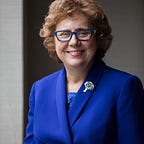There is No Place Like Home
“There is no place like home.” This was the title of the op-ed I recently submitted to the Philadelphia Inquirer and am sharing with you today. It seemed fitting for a multitude of reasons, many of which makes me proud to work at KenCrest, and I hope you do, too. One of those reasons is the way we approached supporting people transitioning from the Hamburg state center. Under the leadership of Kellie Smith, our staff learned in detail the needs of each person and used that knowledge to create two new homes. One of those homes chose The Wizard of Oz as their Halloween theme last year. If you’ve seen the movie, you remember the famous line “there is no place like home.”
I am truly proud of what we do, and it was an honor for me to testify at a hearing regarding institutions in Pennsylvania for individuals with intellectual disabilities on October 21st in front of the Pennsylvania House Health and Human Services Committees. I am proud of KenCrest’s long history of advocacy, including the voices of people like Sister Grace who testified for the right to education. I hope you will express your gratitude to your co-workers today for what they do to make the world a better place.
Pennsylvania is one of 36 states that still operates residential institutions for those with disabilities and serves about 700 individuals between four different institutions. Earlier this year, the Office of Developmental Programs announced its intention to close two of those institutions, Polk and White Haven, over the next three years; it sparked a lot of debate and confusion. Was this the best option for these individuals?
While I have over 45 years of leadership in this field, my driving force for being here has never changed; my desire to see people with intellectual disabilities in community settings, with or close to family. I grew up in a large family that insisted on inclusion; none of my relatives with developmental disabilities left our family for an institution.
Over the years, I heard many stories of families directed to place their newborn with a developmental disability into a nursing home, or at elementary age into an institution. Most families did not follow these directions, and people with developmental disabilities remained with their loved ones. If you were one of the families who needed assistance, placement in an institution was the only option.
Just two years ago at KenCrest, we helped the families of residents of the former state-run Hamburg Center evaluate their choices for their loved one’s future. Most were skeptical that community living as a residential option could meet their relative’s needs. We met with the residents and their relatives and were interviewed by ten families; eight accepted our invitation to join the KenCrest family in a community living setting. The Office of Developmental Programs offered a detailed and caring process to assure that the needs of each person would be met. That process ensured that the family would make the decision. By the time we were ready to move the residents into their new community homes and neighborhoods, one individual had passed away and two were transitioning directly from hospital stays.
Some would raise an alarm about the risks of these transitions. The proof is in the story of those who have moved. Since that time many of these individuals have progressed in their health and social interactions. We’re discovering new things about them every day, and their community has rallied around them. One resident in particular who has multiple disabilities wasn’t making eye contact whatsoever with anyone prior to his arrival; now he recognizes when you’re speaking to him, makes eye contact, and on occasion even smiles. He also has chorea — a disorder that causes frequent body movement. A few weeks after his arrival staff discovered that he enjoys sitting in front of the large windows in the dining room watching the deer in the yard. The deer come unusually close and graze in front the windows; they’re completely un-bothered by his involuntary movements.
All of the individuals have strengthened their connections with their families and see them more frequently than before. We had trick-or-treaters again this year at many of the homes, and we gave out candy while encouraging and educating our neighbors on the care being provided for each of the residents, and the value of people who are different.
Weighing conflicting interests is difficult; we know that some of the choices we have today simply were not available in the past. Many of the dedicated workers at these institutions will face reassignment to other positions within the state, and a community that once benefited financially from the presence of the institution will lose jobs and revenue. What can we mobilize to support those communities so that the lives of the people come first?
We have come a long way in giving choice where there was none. And we have families of young adults who are imagining only a community based service. We have some things to improve. Until we can say that every person can get every service they need at home or close to it, our development work is not done. Building our community capacity needs to be our priority.
As we look to these transitions and the development of our system of services and supports, it’s important to learn what’s possible, explore choices, and know that we can mobilize our resources to create something special for those we serve and their families.
Stand by for the next few blogs which will focus on “home”.
